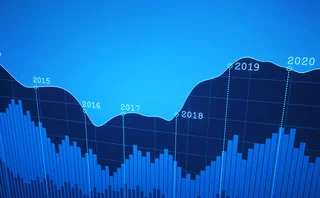
Paying the price for oil
High oil prices will undoubtedly have an impact on the credit markets: the question is, which sectors will be hardest hit and how badly? Credit tries to find some answers

Key points |
• Analysts identify the chemical, auto and airline sectors as most susceptible to fluctuations in oil prices. |
Only five years ago the market was panicking about the price of oil slipping to dangerous lows: the $5 barrel was becoming a genuine prospect. But just last month US oil prices surged to record highs of more than $42, while the price of Brent Crude jumped to $39.
On the back of news that Islamic militants had attacked a residential compound in Saudi Arabia and left 22 people dead, US-traded light, sweet crude reached a historic peak – in nominal terms – of $42.38 and contributed to faster-than-expected growth in US and UK inflation.
But by the beginning of July the price of US-traded oil had slipped back down to around $38 a barrel with most market economists expecting prices to settle at $30 by the first quarter of next year. Investors and analysts in the credit market, however, are still nervous about the effect prices will have on certain investment-grade issuance and fear that any sustained rise in costs will put pressure on company earnings and result in wholesale ratings changes.
“High oil prices will not make or break the credit market on their own, but the impact will be severe on some sectors,” says Roberto Fumagalli, quantitative credit strategist at Citigroup. “Obviously any issuers sensitive to oil price changes will suffer and that puts the chemical sector at the top of the list. Within that, it will be names like BASF and CIBA, which are not legally allowed to pass on increased input prices to their clients because of contractual arrangements, that will be hurt the most, while issuers like Finland-based Dynea, which has no such restrictions, will fare better.”
Outside the chemical sector, there are also worries about airline issuers after Giovanni Bisignani, chief of the Geneva-based International Air Travel Association (IATA), which represents more than 270 airlines, told executives at its annual meeting in Singapore last month that a 20% increase in the cost of oil from $30 to $36 a barrel would turn industry profits of $3 billion into $3 billion of losses. “Last year, we survived the four horsemen of the apocalypse: Sars, conflict in Iraq, terrorism and a depressed economy,” he said. “But a fifth horseman – the price of oil – could add up to $1 billion per month to our costs and deny us profitability yet again.”
As a solution, the IATA is recommending a ticket price rise of 3% for European flights and 5% for international carriers. Whether these surcharges dampen passenger demand and cause further problems for the industry remains to be seen.
On the buy side, fixed-income investors around Europe are already blaming the fluctuations in oil costs for a disappointing month of returns and Portuguese pension fund performance figures from consultant Watson Wyatt show that average monthly returns fell from 0.2% to –0.7% after the yields on international, European government and European corporate bond investments dropped to –1.6%, –0.3% and –0.2% respectively.
“The month started on a high note,” says Carlos Ravara, actuarial consultant at Watson Wyatt in Lisbon. “But it was anything but positive for the capital markets. The combination of inflationary expectations, higher interest rates, continued fighting in the Middle East and a spike in oil prices produced a gloomy situation for pension funds and a negative month of returns from their fixed-income investments.”
But the feeling from most credit analysts and investors is that there is no need for panic and that only a prolonged rise in the price of US-traded light, sweet crude, triggered by some sort of geopolitical shock, would cause real problems for the market.
“I think the key thing to remember is that prices did not stay at nominal historic highs,” says Elissar Boujaoudé, head of fixed-income investment research at Axa Investment Managers. “It confirmed our view that the oil price increase from $35 to $42 was largely speculative and nothing for the credit market to get unnecessarily worked up about.”
Darren Stevens, credit research analyst covering industrials and autos at Lombard Odier Darier Hentsch, however, is not so confident. He believes that the chemical, auto and airline issuers will be immediately affected by the increased price of oil and that in a worst-case scenario, with prices staying above $35 for sustained periods, some borrowers will have their ratings cut by the agencies.
“The auto issuers will get hurt,” he says. “Prices at the pump have gone and will continue to go up and the perception is that people will no longer be able to afford to run gas-guzzling cars such as sports utility vehicles.” The general consensus is that less units will get sold and result in a weakening credit profile for many borrowers. But most issuers, particularly chemical companies, hedge their costs forward by at least six months and so prices would have to stay at $40 for quite some time before it has an impact on underlying company margins. “But if that did happen, then I think the agencies would have no choice but to cut some of their fringe ratings,” adds Stevens.
Macro impact
What commentators do agree on, however, is how the price of oil is affecting the credit market on a macro scale. In the US, where inflation is typically driven by labour cost increases, surging gasoline prices contributed to a faster-than-expected rise in May inflation with the consumer price index (CPI) increasing by 0.6% compared with forecasts of 0.4%. In the UK, the CPI jumped up from 1.2% to 1.5% and prompted the Bank of England to raise interest rates for the second consecutive month to 4.5% and, in the euro area, inflation spiked from 1.6% in February to 2.5% in May, well above the 2% ceiling set by the European Central Bank.
At the same time China’s inflation rate rose to 4.4% from less than 1% a year ago – its highest level for seven years – while even in Japan, which has suffered six years of falling prices, there are clear signs that deflation is easing.
On the equity side, the European and global equity markets hit 2004 lows during the same period with the S&P Europe 350 falling from a March peak of 1,036 points to 967 and the Ftse All World Index slipping almost 9% from 169 to 154.
“Increases [in oil prices] have always been seen as a precursor to an economic slowdown but taken in isolation oil will not really be a deciding factor unless prices hit $50 or $60,” says Neil McLeish, head of European credit strategy at Morgan Stanley. “But the higher oil price is a contributory factor in the broader macro picture, characterised by rising barriers to growth alongside other factors including interest rate hikes and the China slowdown. So although oil is not a decisive factor, it may well be cited later in the year as a contributory factor to negative rating actions.”
But a rise in the CPI does not worry everyone. Before the Federal Reserve met at the end of last month there was a lot of talk from investors that Alan Greenspan would push rates up above forecasts to curb the general upturn in prices but Fumagalli, at Citigroup, argues that inflation is not a real threat to the credit market as it persuades borrowers to focus on what is good for fixed-income investors – the reduction of debt.
“Rising inflation is not a critical issue for the market,” he says. “We will still have economic growth despite increased oil prices but what we will not have is runaway growth, which forces companies to try and keep their earnings growth high and to use their cash for investment purposes rather than paying down debt. Ultimately, bond investors want issuers to make money and reduce their liabilities but when too much money is being made the cash gets diverted into other areas, such as capital expenditure, and this can have a negative affect on balance sheets.”
Deutsche Bank’s equity team has formulated a league table of companies most at risk from hikes in the price of oil. Andrew Griffiths, director of credit research at the bank, says: “When the potential ramifications of a high oil price environment are discussed, the chemicals sector immediately springs to the fore. The companies most affected by a high oil price environment are those such as Bayer, Degussa and ICI.”
Griffiths adds: “Those least affected, unsurprisingly, are the industrial gases players such as Air Liquide and BOC. But taken in isolation, we do not believe a rise in oil prices will have any significant impact on company credit ratings or spread levels on company bonds.”
And it seems as if Griffiths is right. In the last few weeks Air Liquide, a French industrial gases manufacturer, was able to successfully tap the market for €1 billion of debt in six and 10 years and attract a complete book of buy-and-hold investors. The 10-year €500 million trade tightened from 35bp over mid-swaps to 33bp upon release. “We priced in line with RWE and came with no new-issue premium,” says the firm’s deputy chief financial officer, Maelys Castella. “The issue offered a defensive non-cyclical investment that investors could lock away in their portfolios and never have to worry about.”
And that seems to be the general sentiment of the market. Had oil prices stayed in excess of $40 a barrel until the end of the year, the spreads on a range of borrowers, not just chemical, auto and airline issuers, would have suffered along with their credit ratings. But unlike the 1970s, when the price of oil soared to real historic highs and pushed average inflation up to highs of 13% from levels of 2-3% during most of the 1960s, last month’s spike was not driven by supply-side shocks.
Higher-than-expected demand for oil in industrialised countries and China’s rapidly expanding economy, which saw industrial production up by 17.5% in May compared with the same period last year, have created a huge demand boost for oil, but figures show that the world economy is now slowing and that the Chinese market is starting to overheat.
On top of that, Opec has agreed to raise output by two million barrels a day from the beginning of this month and by another 500,000 a day from the start of August, prompting economists to revise down their oil price forecasts to around $30 for 2005. The upshot for the credit arena is that the current price will not pose any permanent problems for the market and that only a geopolitical shock, such as a direct attack on Iraqi oilfields, could send spreads widening and ratings plummeting.
“The short-term fear factor associated with the recent oil price rises is dissipating,” says Stevens at Lombard Odier Darier Hentsch. “Commodity prices around the world have all peaked and fallen and oil is the last to do so. The world economy is slowing and the fact that issuers most acutely affected by the June price rise have hedged their costs forward for the next six to 12 months, means it is not a real problem. Prices did hit nominal highs but they are nothing compared with what happened in the 1970s in real terms. The market has moved on and it is no longer oil prices, but the problems associated with rising interest rates, that are taking centre stage.”
Only users who have a paid subscription or are part of a corporate subscription are able to print or copy content.
To access these options, along with all other subscription benefits, please contact info@risk.net or view our subscription options here: http://subscriptions.risk.net/subscribe
You are currently unable to print this content. Please contact info@risk.net to find out more.
You are currently unable to copy this content. Please contact info@risk.net to find out more.
Copyright Infopro Digital Limited. All rights reserved.
As outlined in our terms and conditions, https://www.infopro-digital.com/terms-and-conditions/subscriptions/ (point 2.4), printing is limited to a single copy.
If you would like to purchase additional rights please email info@risk.net
Copyright Infopro Digital Limited. All rights reserved.
You may share this content using our article tools. As outlined in our terms and conditions, https://www.infopro-digital.com/terms-and-conditions/subscriptions/ (clause 2.4), an Authorised User may only make one copy of the materials for their own personal use. You must also comply with the restrictions in clause 2.5.
If you would like to purchase additional rights please email info@risk.net
More on Economics
Global investment outlook: 2026 and beyond
Broadening, steepening and weakening: Franklin Templeton’s top investment ideas for 2026 and beyond
Webinar – Nowcasting the US economy
Join CME Group Chief Economist, Blu Putnam, as he shares insights using alternative data and nowcasting to monitor developments in the US economy.
Fed Funds Futures in a Post-ZIRP World
As the FOMC returns to more active management of its key target rate, Federal Funds futures have experienced dramatic growth.
Challenging economic pessimism: an optimistic note
A contrarian, upbeat view of the long-term economic outlook
Economists, like hedge fund traders, need open minds
Economists, risk managers and traders must learn the lessons of crisis, says Kaminski
Fed wrong not to start QE tapering, says UBS economist
The surprise decision by the Federal Reserve last month not to scale back its quantitative easing programme will create more volatility, says economist







